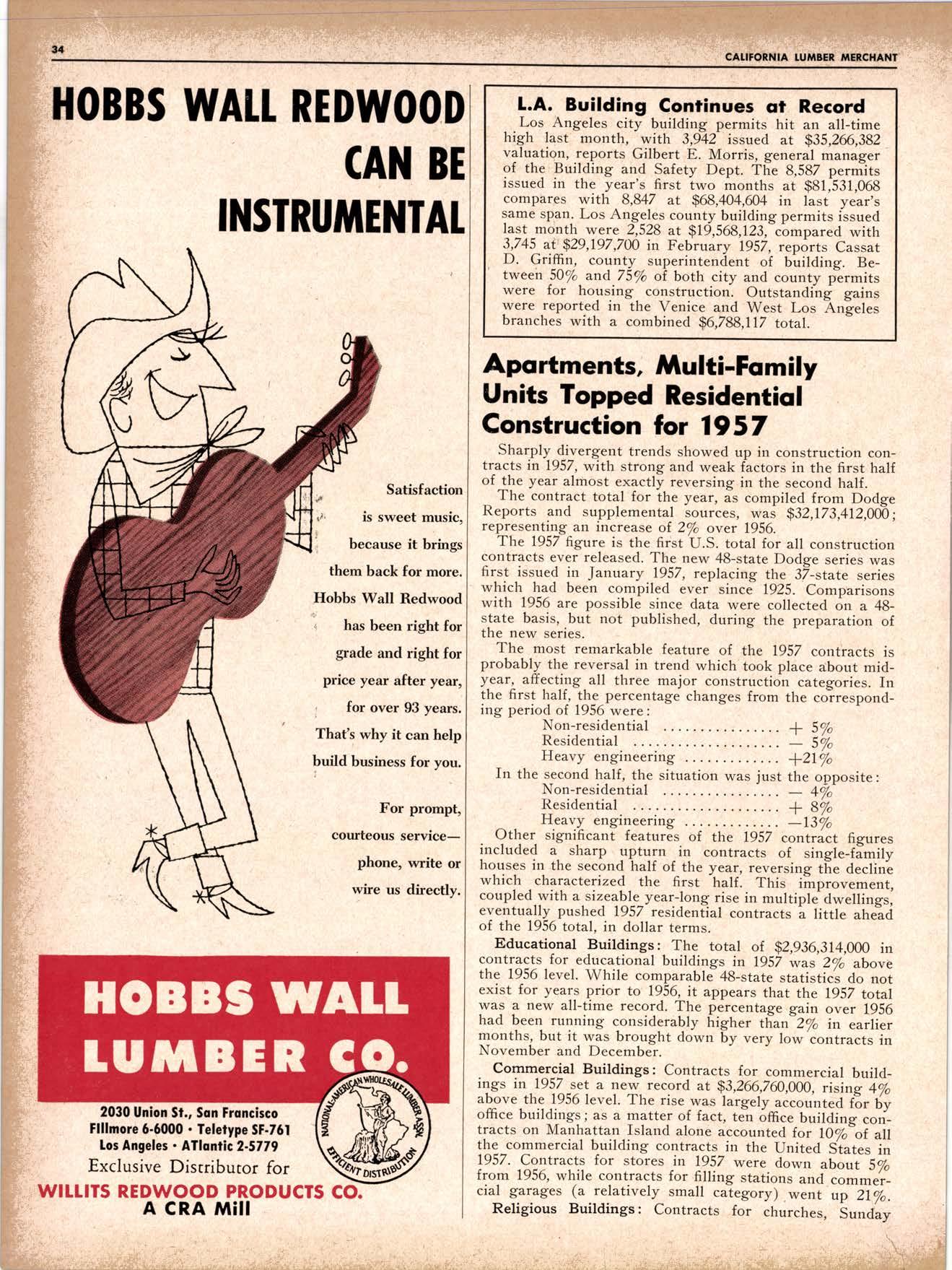
2 minute read
REDWOOD CAl{ BE I]{STRUfrIE]{TAT
L.A. Building Continues ot Record
lor Angeles city building permits hit an all-time high last month, with 3,t42- issued at g35,266,382 valuatio:r, -reports Gjlb_ert E. Morris, general manager of the Building and Safety Dept. The 8,587 perm-its issued in the year's first iwo months "i $gt,SSt,OOg compares with 8,847 at 968,404,604 in last year,s same span. Los Angeles county building permits issued pg! _mon1! ^ w er e-2,528 at 919,568, I 23,- iompared with 3,745^at-$29,197,7tn in February 1957, reports Cassat D. Gn$1, coun-ty.superintendent of Uiritaing. Between 50/o.and 75% of. both city and county pirmits were for housing_ construction. Outstanding gains were .reported in the Venice and West Los Anleles branches with a combined $6,788,112 total.
Aportments, filulti-Fomily Units Topped Residentiol Construction for 1957
Satisfaction v.,. is sweet music.
. because it brings them back for more.
Hobbs WaIl Redwood q has been right for grade and right for price year after year, for over 93 years.
That's why it can help build business for vou. For prompt, courteous servicephone, write or wire us directly.
Sharply divergent trends showed up in construction contracts in L957, with strong and weak factors in the first half of the year almost exactly reversing in the second half. The contract total for ihe year, is compiled from Dodge Reports and supplemental sources, wa€ 932,173,412,ffi; representing an increase of.2/o over 1956.
The 1957 figure is the first U.S. total for all construction contracts ever released. The new 48-state Dodge series was first issued in January 7957, replacing the 37-state series which had been compiled evei sincJ 1925. Comparisons rvith 1956 are possible since data were collected on a 48state basis, but not published, during the preparation of the new series.
The most remarkable feature of the 1957 contracts is probably the reversal in trend which took place about midy.ear, afrectilg.all three major constructioh categories. In the first half, the_percentage changes from the co-rrespond- ing period of 1956 were:
Non-residential .... + S%
Residential ..S%
Heavy engineering +Zl%
In the second half, the situation was just the ooposite: Non-residential .'...4E; Residential .. + 8% _
Heavy engineerirg .. -I3%
Qtler. significant features of the l95Z contract figures included a. sharp upturn -in contracts of single-fimily houses in the second- ha_lf of_the year, reversing tEe declinl which characterized the first -half. This iirprovement, coupled_with a sizeabl-e_year-long r_ise in multiple dwellings, eventually pushed 1957 residential contracts i little ahiad of the 1956 total, in dollar terms.
.
Educational Buildings: The total of $2,936,314,000 in contracts for educational buildings -in 1957 was' 2/i abovb the 1956 level. While comparablJ48-state statistics do not exist for years prior to 1956, it appears that the 1957 total was a new all-time record. The pCrcentage gain over 1956 had been running considerally higher tian"2/o in eartiei months, but it was brought down 6y very low contracts in November and December.
Commercial Buildings: Contracts for commercial build_ ings in_1957^_s9t, a new. record at g3,266,2ffi,000, risii,g i/o above the 1956 level. The rise was largely accounted f6, fiv office buildings; as a matter of fact, ten office buildine-cori_ tracts on Manhattan Island alone accounted for lO/o"of. all the commercial building contracts in the United Si;G l; 1957. Contracts for stores in l9S7 were down "iil-Si" from 1956, while contracts for fi.lling stations and comm-# cial garages (a relatively_ small category) we"t up ii\.
Religious Buildings: Contracts for churches, Sundav









